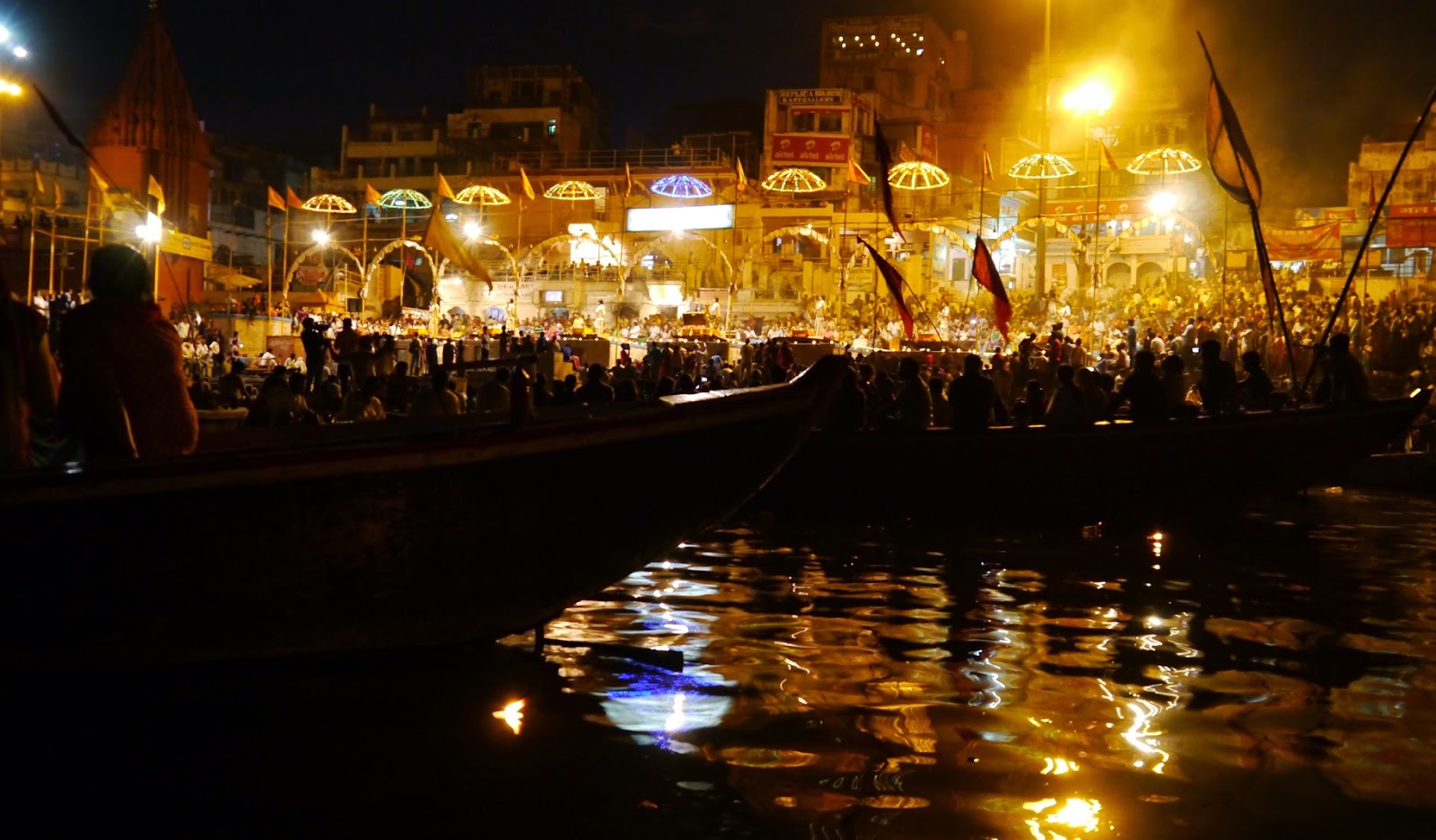Saturday 24th May 2014
“Older than history,
older than tradition, older even than legend, and looks twice as old as all of
them put together.” – Mark Twain’s famous quote about Varanasi, or
Banaras/Benares as it is also known. The city is indeed old, having had
religious life present since the sixth century BC, and is the centre-point of
the Hindu universe. Situated on the banks of the vast River Ganges, the maze of
alleys which makes up the Old City, the ghats which line the river, and the
endless stream of pilgrims pouring through give it a very special feeling. I’m
not really one for religion or spirituality, but there is certainly something
about Varansi that makes one feel different. I stayed at the charming Ganpati
Guest House (itself a renovated ghat), where I met two lovely American ladies
who had been on my flight from Calcutta, with whom I would spend my time in
Varanasi. By the way, ghats are the sets of stone steps (and the palaces,
pavilions, and terraces) which line the river – the are 100 in Varanasi – and
serve as sites for bathing, laundry, and rituals etc.
Our
first morning consisted of a tour of the labyrinthine streets of the Old City,
with stops at the Nepali Temple, Alamgir Masjid, and Golden Temple, as well as
various smaller temples and shrines along the way. The Nepali Temple is around
three hundred years old (according to our guide) and is a Kathmandu-style
wooden structure, dedicated to Lord Shiva, with beautiful carvings, including
depictions of various positions from the Kama Sutra.
 |
| Whispering a wish to the bull for Lord Shiva. |
The Alamgir Masjid stands
on the ruins of a Vishnu temple that was later replaced with the mosque. It is
a testimony to favourable Hindu-Muslim relations as it is on the site of the
initiation of the saint Kabir, the son of a humble Muslim weaver who is revered
by both Hindus and Muslims. Despite its minarets now being much shorter than
they once were, the structure remains magnificent, and casts an impressive
silhouette over the river at dawn and dusk. With non-Hindus not being allowed
into the Golden Temple, we made do with glances of its gilded spire from
surrounding buildings. It is by far Varanasi’s most popular temple. There was
also a brief and rather awkward stop at an aromatherapy centre (tourist trap)
during which I managed to suppress my scoffs (sorry, but I don’t believe that
rubbing oil on the skin is going to cure arthritis or stop me from getting
spots), and from which we made a swift exit after the ‘headache cure’ oil
reacted with my skin and made my eyes water. Some of them did smell quite nice,
though.
 |
| Alamgir Masjid. |
Following a long afternoon walk along the ghats (yes, the weather did
allow such, surprisingly!) we took an evening boat ride up to Manikarnika Ghat,
the city’s biggest burning ghat, where cremations take place. We’d seen several
corpses being carried through the streets during the day, and now witnessed
their submersion in the river and subsequent burning. Whilst not entirely
comfortable at this being a tourist spectacle, the process is very much public,
and an interesting and edifying insight into Hindu culture. We then watched the
group of priests at Dashashwamedh Ghatperform Agni Pooja ceremony (Worship to Fire) wherein a dedication is made
to Lord Shiva, River Ganga, Surya (Sun), Agni (Fire), and the whole universe.
 |
| Ceremonies at Dashashwamedh Ghat from the boat. |
Friday
morning started painfully early, with a 5am boat ride to watch the sun rise
over the Ganges. I was bleary-eyed to say the least, but the glorious sight
soon roused me, it was simply extraordinary. We continued in the boat along the
ghats, watching them come to life with bathers, swimmers, launderers (sheets
and clothes, not money), and priests.
 |
| Sunrise on the Ganges. |
 |
| Early morning life. |
The
sweltering afternoon (the nice weather was never going to last), brought with
it a trip to Sarnath, a village 10km north of Varanasi. In 530 BC, Buddha gave
his first ever sermon here. Upon this site now stands Dhamekh Stupa, a 33.5m
high tower, decorated with geometric patters and bas-relief foliage. Buddhist
communities from other countries are also represented in the village, and have
their own temples. Those represented include Tibetan, Chinese, Japanese, Thai,
and Burmese communities. We visited a couple of them, but apart from their
religious significance, held little interest for non-Buddhist or those (such as
myself) with very limited knowledge of the philosophy. The Thai temple had an
enormous statue of Buddha. On one of my usual find-the-post-office missions (I send copious amounts of postcards) I came across a snake-charmer in the street. He tried to get my attention by shaking his basket at me, which contained a very large black Cobra. Needless to say, I almost fainted. Not many people can move through the tiny streets of Varanasi as quickly as I did at that moment.
That
evening, we watched the ceremonies on Dashashwamedh Ghat amongst the crowds
around the priests on the ghat itself. And also, the city is full of cows, and the river full of buffalo.
 |
| Ceremonies at Dashashwamedh Ghat. |
I’m
sitting writing this at Varanasi airport while waiting for my flight to Agra,
where I’ll meet Lena, and visit the Taj Mahal, my fourth ‘Wonder of the World’.
I can’t wait.

No comments:
Post a Comment